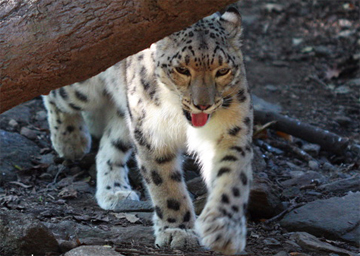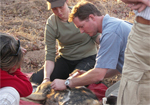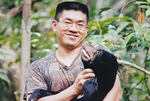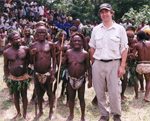Wildlife experts descend on San Francisco
Wildlife experts descend on San Francisco
mongabay.com
September 30, 2008
|
|
Wildlife experts from around the world are arriving in San Francisco ahead of a conservation expo that gives the public the opportunity to meet, in person, the people who are saving endangered wildlife.
The event — put on by the Wildlife Conservation Network, an innovative group that uses a “venture capital” model to support promising conservation projects — will showcase the efforts of 18 conservationists on Saturday, October 4th from 10 am to 6 pm at the Mission Bay Conference Center in San Francisco. Admission to the fundraiser is $25 for students (with ID) and $50 for adults.
Presenters at the Wildlife Conservation Expo include a broad array of wildlife experts.

Snow leopard |
Dr. Rodney Jackson of the Snow Leopard Conservancy, a group that is working to preserve snow leopards in India, Mongolia, Nepal, Pakistan, Tibet, and Tajikistan.
Dr. Robert Williams of the Association for the Conservation of Otters of the Peruvian Amazon.
Elena Bykova of the Saiga Conservation Alliance. The saiga is an antelope found steppes and plains of Central Asia and Russia. The species once numbered in the millions, but today only 40,000 survive after a 96 percent drop in the past decade — the fastest decline ever recorded for a mammal species.
Siew Te Wong of Bornean Sun Bear Conservation, a Malaysia-based group that aims to better understand the world’s rarest bear species and protect it from poaching, habitat destruction by loggers and the palm oil industry.
Greg Rasmussen and Peter Blinston of Painted Dog Conservation, an organization that protects African wild dogs while simultaneously creating rural livelihoods and educational opportunities in Zimbabwe.
Dr. Dale Miquelle, a Wildlife Conservation Society scientist, who works on Amur tiger and leopard conservation in Russia’s Far East.
Dr. Claudio Sillero of the Ethiopian Wolf Conservation Program. Sillero works with local communities to protect the Ethiopian wold, one of the world’s most threatened species of mammal.
Colleen Begg of the Niassa Carnivore Project, a honey badger research and conservation project in Southern Africa that involves local beekeepers.
Dr. Iain Douglas-Hamilton, founder of Save the Elephants, a leading elephant conservation group. Douglas-Hamilton was the first to alert the world to the poaching crisis in the 1980s and helped bring about the global ivory trade ban.
Dr. Mauro Lucherini of the Andean Cat Alliance, a four country initiative that seeks to study and protect one of the world’s most endangered and least-known cats, the Andean mountain cat.
Rebecca Klein of Cheetah Conservation Botswana.
Rogerio Cunha de Paula of ProCarnivoros, a Brazil-based conservation outfit. Cunha de Paula is focused on the Maned wolf, a fox-like canid found in grasslands and open woodlands in South America.
Rosamira Guillen of Proyecto Titi, a project that seeks to protect Cotton-top tamarin through conservation and a successful community development program that turns trash into attractive handbags.
Dr. James Sanderson of the Small Cat Conservation Alliance, an organization that works to protect threatened small cat species around the world.
Megan Parker of Working Dogs for Conservation, a group that trains drogs for scientific work and conservation.
Dr. Alecia Lilly of The Dian Fossey Gorilla Fund International, an organization that aims to protect gorillas and their habitat through anti-poaching, monitoring, research, education and support of local communities.
Dr. Laurie Marker of the Cheetah Conservation Fund in Namibia.
Wildlife Conservation Expo
Related articles

|
(09/30/2008) The planet’s fastest land animal is falling behind in its race for survival against habitat encroachment, loss of prey, the illegal wildlife trade, and disease. Once found widely across the African continent to Kazakhstan in the north to Burma in the East, the cheetah has seen a dramatic reduction of its range and numbers in recent centuries as livestock holders have relentlessly killed off the cat as a threat to their livelihoods. Today the cheetah clings to strongholds in only a few African nations. Among these is the southern African country of Botswana, which harbors large expanses of prime cheetah habitat. Cheetah Conservation Botswana (CCB) is working to preserve the country’s cheetah population through scientific research and community outreach and education. In an interview ahead of an upcoming appearance in the U.S., CCB co-founder Rebecca Klein spoke about her organization’s work and its efforts to conserve cheetahs while delivering benefits to local communities.

|
(09/29/2008) The painted dog, or African wild dog, was once found widely across Africa but relentless persecution by humans, coupled with habitat loss and spread of disease from domestic dogs, has driven the population down from 500,000 to less than 5,000 over the past century. The species is now listed as endangered by the IUCN. While the outlook is not good in many countries, there are emerging signs of hope, particularly in Zimbabwe where the efforts of a community-based conservation project has nearly doubled the population of the dog to 700 individuals.

|
(09/29/2008) One of the world’s rarest cats is also one of its least known. The Andean mountain cat, sometimes called the “snow leopard” of the Andes, is an elusive species found only at high elevations of the Andean region in Argentina, Bolivia, Chile and Peru. Little is known about its ecology and behavior. While the species is known to be rare, no one knows how many individuals survive in the wild. Mauro Lucherini and his colleagues at the Andean Cat Alliance(AGA) are working to change this.

|
(09/25/2008) A small, but charismatic primate has become the symbol for conservation efforts in an area of threatened forest in northwestern Colombia, says a conservationist who helped pioneer a successful community development program that turns trash into attractive handbags. Rosamira Guillen, Executive Director of the Fundación Proyecto Tití, is working with local communities to protect the endangered Cotton-top tamarin and its tropical dry forest habitat in northwestern Colombia. The effort relies heavily on creating alternative livelihoods for local people who would otherwise collect the squirrel-sized primate for the pet trade or raze its habitat for agriculture. In the process, Fundación Proyecto Tití has created a thriving business that converts plastic bags — a source or mortality among cotton-top tamarins — into fashionable "eco-mochilas" that are now sent all over the world.

|
(09/25/2008) Industrial logging, large-scale forest conversion for oil palm plantations, and the illegal wildlife trade have left sun bears the rarest species of bear on the planet. Recognizing their dire status, Siew Te Wong, a Ph.D. candidate at the University of Montana, is working in Malaysia to save the species from extinction. Known as “Sun Bear Man” in some circles, Siew Te Wong is setting up the Bornean Sun Bear Conservation Centre (BSBCC) in Sabah, a Malaysian state on the island of Borneo. The project aims to save sun bears, which have largely overlooked by conservationists, through research, education, rehabilitation, and habitat conservation.
Group takes “venture capital” approach to conservation

|
(09/16/2008) An innovative group is using a venture capital model to save some of the world’s most endangered species, while at the same time working to ensure that local communities benefit from conservation efforts. The Wildlife Conservation Network (WCN), an organization based in Los Altos, California, works to protect threatened species by focusing on what it terms “conservation entrepreneurs” — people who are passionate about saving wildlife and have creative ideas for dong so. After a rigorous review process to identify and select projects that will have the greatest impact on conservation in developing countries, WCN provides the conservationist with fund-raising and back-office support, technology, and access to its network of people and resources.